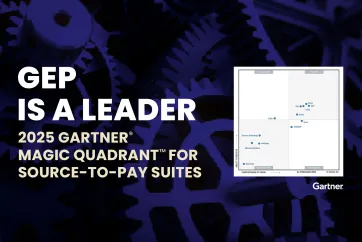
Private Equity Meets Procurement: The Engine Behind Value Creation
- Procurement boosts EBITDA and drives efficiency in private equity portfolio companies.
- Early implementation ensures maximum impact.
- Digital tools and centralizing spend unlocks efficiencies.
February 06, 2025 | Procurement Strategy
In the high-stakes world of private equity, where every basis point of EBITDA matters and hold periods are shrinking, procurement has emerged as a decisive lever for value creation. Gone are the days when procurement was relegated to back-office cost-cutting. Today, forward-thinking PE firms treat it as a strategic function—one that accelerates margin growth, de-risks portfolios, and primes companies for lucrative exits.
Why Is Procurement Optimization Important in Private Equity?
Private equity thrives on speed and precision, and procurement delivers both. Unlike traditional corporate environments, PE-backed procurement strategies are engineered for rapid EBITDA (earnings before interest, taxes, depreciation, and amortization) impact. By focusing on supplier renegotiation, spend aggregation, and tail spend management, firms unlock margin expansion that directly fuels valuation multiples.
● Cost Reduction
Procurement helps identify opportunities to renegotiate supplier contracts, consolidate spend across multiple companies, and leverage economies of scale.
● Operational Efficiency
Streamlined procurement processes reduce inefficiencies and improve supply chain resilience.
● Value Creation
Procurement initiatives are often low-hanging fruit for PE firms looking to improve financial performance quickly during the investment lifecycle.
For PE firms operating under tight timeframes to deliver returns, procurement offers a tangible and measurable way to unlock value early in the ownership period.
When Should Procurement Initiatives Begin?
Procurement initiatives should begin as early as the due diligence phase of an acquisition. During this phase, PE firms can assess the procurement maturity of the target company and identify opportunities for improvement. A robust procurement strategy should then be implemented within the first 100 days post-acquisition to maximize impact.
● Pre-Acquisition (Due Diligence)
PE firms analyze spend data, supplier contracts, and procurement processes to identify quick wins and long-term opportunities.
● Post-Acquisition (First 100 Days)
The initial phase post-acquisition is critical for implementing procurement strategies that align with the investment thesis. This may include renegotiating contracts, consolidating suppliers, or implementing digital tools.
Starting early ensures that procurement becomes a strategic focus throughout the ownership period rather than an afterthought.
How Do PE Firms Manage Procurement Across Their Portfolio Companies?
Private equity firms often manage multiple portfolio companies with diverse procurement needs. To drive efficiencies and cost savings at scale, they adopt several strategies:
Meanwhile, Unilever’s refillable packaging models for products like deodorants and shampoo offer a glimpse into a future where packaging is reusable rather than disposable. Procurement professionals can draw inspiration from these examples to tailor strategies that fit their own supply chains.
● Spend Aggregation
By consolidating spend across portfolio companies, PE firms can negotiate better terms with suppliers. For example, a PE firm with multiple consumer goods companies can combine their packaging spend to secure bulk discounts from suppliers. Also, centralized purchasing agreements enable cost savings through volume-based pricing.
● Supplier Consolidation
Reducing the number of suppliers across portfolio companies simplifies supply chain management and strengthens relationships with key vendors. This approach also improves consistency in quality and service levels.
● Group Purchasing Organizations (GPOs)
Some PE firms join or create GPOs to pool purchasing power across their portfolio companies. GPOs enable smaller companies within a portfolio to access supplier discounts typically reserved for larger enterprises.
● Digital Procurement Platforms
Digital tools like spend analytics platforms, e-sourcing tools, and contract management systems provide visibility into spending patterns and help identify opportunities for optimization across the portfolio.
By taking a centralized approach to procurement management while allowing flexibility for individual company needs, PE firms can achieve significant cost savings without disrupting operations.
What Challenges Do PE Firms Face in Implementing Procurement Strategies?
While procurement offers immense potential for value creation, it also comes with unique challenges in the context of private equity:
● Supplier Resistance
Suppliers may resist renegotiating contracts or offering discounts when dealing with multiple portfolio companies under a single umbrella. Building strong supplier relationships is crucial to overcoming this challenge.
● Diverse Procurement Systems
Portfolio companies often operate independently before being acquired by a PE firm. Integrating disparate systems, processes, and supplier networks can be complex and time-consuming.
● Limited Timeframes
PE firms typically operate on a 3-7 year investment horizon. This creates pressure to deliver results quickly, leaving little room for trial-and-error approaches in procurement optimization.
● Change Management
Implementing new procurement strategies often requires cultural change within portfolio companies. Resistance from employees or leadership teams can slow down progress.
To address these challenges, many PE firms rely on external consultants or specialized procurement teams with expertise in navigating complex supply chains.
What Tools and Technologies Are Used to Optimize Procurement?
Digital transformation has changed how procurement operates within private equity. Leveraging technology not only improves efficiency but also provides actionable insights for decision-making. Here are some key tools used by PE firms:
● Spend Analytics Platforms
These platforms analyze historical spend data to identify inefficiencies and uncover cost-saving opportunities. They also provide visibility into spending patterns across all portfolio companies.
● E-Sourcing Tools
E-sourcing platforms streamline supplier selection processes by enabling competitive bidding, reverse auctions, and automated negotiations.
● Contract Management Systems
Contract management tools ensure compliance with negotiated terms and help track contract renewals or expirations to avoid missed opportunities for renegotiation.
● Supplier Performance Management Tools
These tools monitor supplier performance metrics such as delivery times, quality standards, and cost adherence to ensure alignment with business goals.
● AI-Powered Forecasting
Artificial intelligence (AI) is increasingly being used to predict demand trends, optimize inventory levels, and mitigate supply chain risks proactively.
By adopting these tools, PE firms can drive efficiency while maintaining control over complex procurement operations across their portfolios.
How Does Procurement Contribute to Exit Strategies?
Procurement improvements not only enhance operational performance during ownership but also increase the attractiveness of a company at exit. Buyers often view streamlined supply chains and optimized cost structures as indicators of a well-run business.
● Higher Valuation
Cost savings achieved through procurement directly improve EBITDA, which is a key driver of valuation multiples.
● Operational Resilience
A robust procurement function reduces risks associated with supply chain disruptions —an appealing factor for potential buyers.
● Scalability
Digitalized and centralized procurement processes make it easier for new owners to scale operations post-acquisition.
By embedding efficient procurement practices early in the investment lifecycle, PE firms position their portfolio companies for successful exits at higher valuations.
Conclusion
From pre-acquisition due diligence to post-exit planning, effective procurement strategies help PE firms reduce costs, mitigate risks, and drive sustainable growth across their portfolios. As private equity continues to evolve in an increasingly competitive landscape, those who prioritize procurement will gain an edge—not just in cost savings but also in building resilient businesses poised for long-term success.
Learn how GEP can help.



